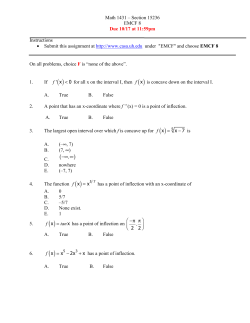
Name: AP
Name: AP CALCULUS BC 1. Find all inflection points for ( ) 2. Find the maximum value of ( ) on [–2,3]. (Find the y number at the absolute maximum point) 3. Find the absolute minimum value (the y number) of ( ) on [-1,2]. 4. Which point on the graph of f(x) is f ' (x) < 0 and f " (x) > 0? 5. The curve of ( ) is concave down on what interval? 6. Find all critical points for ( ) 7. On what intervals is ( ) . increasing? 8. A couple have enough wire to construct 160 ft of fence. They wish to use it to form three sides of a rectangular garden, one side of which is along a building. Find the dimensions that will yield the largest area. 9. A function ƒ is continuous on the interval [–3, 3] such that ƒ(–3) = 4 and ƒ(3) = 1. The functions ƒ‘ and f ’’ have the properties given in the table below: x f ’(x) f ‘’(x) –3 < x< –1 Positive Positive x = –1 Fails to Exist Fails to Exist –1 < x < 1 Negative Positive x=1 Zero Zero 1<x<3 Negative Negative a) What are the x–coordinates of all the absolute maximum and absolute minimum points of ƒ on the interval [–3, 3]? Justify your answer. b) What are the x–coordinates of all points of inflection of ƒ on the interval [–3, 3]? Justify your answer. c) Sketch and label a graph that satisfies the given properties of ƒ. A particle moves along a horizontal line so that its position at any time is given by ( ) , where s is measured in meters and t in seconds. (a) Find the instantaneous velocity at time t and at t = 4 seconds. (b) When is the particle at rest? Moving to the right? Moving to the left? Justify your answers. (c) Find the displacement of the particle after the first 8 seconds. (d) Find the total distance traveled by the particle during the first 8 seconds. (e) Find the acceleration of the particle at time t and at t = 4 seconds. (f) When is the particle speeding up? Slowing down? Justify your answers.
© Copyright 2025





















